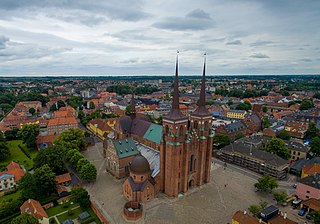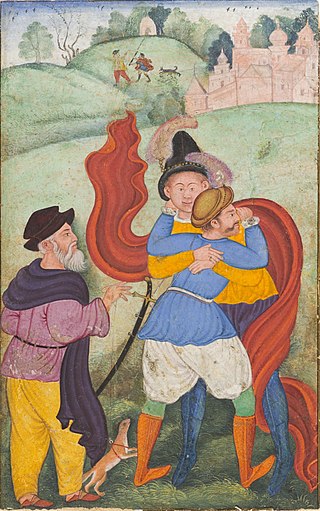Chain migration is the social process by which immigrants from a particular area follow others from that area to a particular destination. The destination may be in another country or in a new location within the same country.

Christianity is the largest religion in Denmark. As of 2022, 72.5% of the population of Denmark were registered members of the Church of Denmark, the officially established church, which is Protestant in classification and Lutheran in orientation.

Islam in Denmark, being the country's largest minority religion, plays a role in shaping its social and religious landscape. According to a 2020 analysis by Danish researcher Brian Arly Jacobsen, an estimated 256,000 people in Denmark — 4.4% of the population — were Muslim in January, 2020. The figure has been increasing for the last several decades due to multiple immigration waves involving economic migrants and asylum seekers. In 1980, an estimated 30,000 Muslims lived in Denmark, amounting to 0.6% of the population.
Turks in Germany, also referred to as German Turks and Turkish Germans, are ethnic Turkish people living in Germany. These terms are also used to refer to German-born individuals who are of full or partial Turkish ancestry. Whilst the majority of Turks arrived or originate from Turkey, there are also significant ethnic Turkish communities living in Germany who come from Southeastern Europe, the island of Cyprus, as well as Turkish communities from other parts of the Levant. At present, ethnic Turkish people form the largest ethnic minority in Germany. They also form the largest Turkish population in the Turkish diaspora.
Illegal immigration is the migration of people into a country in violation of that country's immigration laws, or the continuous residence in a country without the legal right to. Illegal immigration tends to be financially upward, from poorer to richer countries. Illegal residence in another country creates the risk of detention, deportation, and/or other sanctions.
Codevelopment is a trend of thought and a development strategy in development studies which considers migrants to be a developing factor for their countries of origin.

The Somali diaspora or Qurbajoogta refers to Somalis who were born in Greater Somalia and reside in areas of the world that they were not born in. The civil war in Somalia greatly increased the size of the Somali diaspora, as many Somalis moved from Greater Somalia primarily to Europe, North America, Southern Africa and Australia. There are also small Somali populations in other pockets of Europe and Asia. The UN estimates that in 2015, approximately 2 million people from Somalia were living outside of the country's borders.
Turks in the Netherlands refers to people of full or partial Turkish ethnicity living in the Netherlands. They form the largest ethnic minority group in the country; thus, the Turks are the second-largest ethnic group in the Netherlands after the ethnic Dutch. The majority of Dutch Turks descend from the Republic of Turkey; however, there has also been significant Turkish migration waves from other post-Ottoman countries including ethnic Turkish communities which have come to the Netherlands from the Balkans, the island of Cyprus, as well as from other parts of the Levant. More recently, during the European migrant crisis significant waves of Turkish minorities from Syria and Kosovo have also arrived in the Netherlands. In addition, there has been migration to the Netherlands from the Turkish diaspora; many Turkish-Belgians and Turkish-Germans have arrived in the country as Belgian and German citizens.
A transnational marriage or international marriage is a marriage between two people from different countries/races. It can either be a marriage between two people of the same race from two different countries living in the same country or marriage between two people from two different countries with different races.

Immigration to Europe has a long history, but increased substantially after World War II. Western European countries, especially, saw high growth in immigration post 1945, and many European nations today have sizeable immigrant populations, both of European and non-European origin. In contemporary globalization, migrations to Europe have accelerated in speed and scale. Over the last decades, there has been an increase in negative attitudes towards immigration, and many studies have emphasized marked differences in the strength of anti-immigrant attitudes among European countries.
Turks in Denmark, also referred to as Turkish Danes or Danish Turks refers to ethnic Turkish people living in Denmark. They currently form the largest ethnic minority group in the country; thus, the Turks are the second-largest ethnic group in Denmark, after the ethnic Danish people. The majority of Danish Turks descend from the Republic of Turkey; however, there has also been significant Turkish migration from other post-Ottoman countries including ethnic Turkish communities which have come to Denmark from the Balkans, the island of Cyprus, and more recently Iraq and Syria.
Pakistanis in Japan form the country's third-largest community of immigrants from a Muslim-majority country, trailing only the Indonesian community and Bangladeshi community. As of June 2023, official statistics showed 23,417 registered foreigners of Pakistani origin living in the country. There were a further estimated 3,414 illegal immigrants from Pakistan in Japan as of 2000. The average increase in the Pakistani population is about 2-3 persons per day.

Denmark–Pakistan relations are the foreign relations that are established between Pakistan and Denmark. Pakistan has an embassy in Copenhagen. Denmark also has an embassy in Islamabad; it suffered a suicide car bomb attack in June 2008, killing five Pakistanis and one Dane.
Azerbaijan though not a popular destination for immigrants, has recently experienced waves of immigration with the collapse of the Soviet Union, especially from ethnic Azerbaijanis mostly from Armenia, Russia and the rest of the former Soviet Union. Meskhetian Turks were also relocated to Azerbaijan from Central Asia before and after the end of the Soviet Union. With the booming petroleum industry, immigration from Turkey has also followed. In 2010, every eighth resident in Azerbaijan was a migrant, of whom more than 90% of them are Azerbaijanis and 70% are internally displaced persons from the territories occupied by Armenia.
Somalis in Pakistan are residents of Pakistan who are of Somali ancestry. They are a small community of mainly students as well as some secondary migrants, most of whom arrived after the start of the civil war in Somalia in the early 1990s.
Denmark has seen an increase in immigration over the past 30 years, with a large part of the immigrants originating from non-Western countries. As of 2014, more than 8 percent of the population of Denmark consists of immigrants. As of Q2 of 2022, the population of immigrants is 652,495, excluding Danish born descendants of immigrants to Denmark. This shift in demographics has posed challenges to the nation as it attempts to address cultural and religious differences, labour shortages, employment gaps, education of immigrants and their descendants, spatial segregation, crime rates and language abilities.

Ahmadiyya is an Islamic branch in Denmark, under the spiritual leadership of the caliph in London. Kamal Yousuf, an Ahmadi Muslim missionary, who was appointed for disseminating Ahmadiyya teachings in Scandinavia, first toured Denmark in 1956. The earliest Danes to have converted to the movement were from the 1950s and the Community was first established in 1959, during the last few years of the Second Caliphate. Today, there are two Ahmadi mosques, of which one is purpose-built mosque, the oldest in the country. There are an estimated 600 Ahmadi Muslims in the country.
Hometown associations (HTAs), also known as hometown societies, are social alliances that are formed among immigrants from the same city or region of origin. Their purpose is to maintain connections with and provide mutual aid to immigrants from a shared place of origin. They may also aim to produce a new sense of transnational community and identity rooted in the migrants' country of origin, extending to the country of settlement. People from a variety of places have formed these associations in several countries, serving a range of purposes.

European Pakistanis are the residents of Pakistan who are of full or partial European origin.

British Punjabis are citizens or residents of the United Kingdom whose heritage originates wholly or partly in the Punjab, a region in the Indian subcontinent, which is divided between India and Pakistan. Numbering 700,000 in 2006, Punjabis represent the largest ethnicity among British Asians. They are a major sub-group of the British-Indian and British Pakistani communities.









